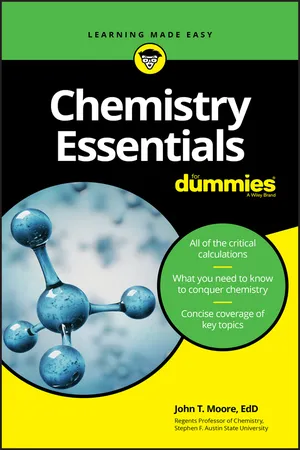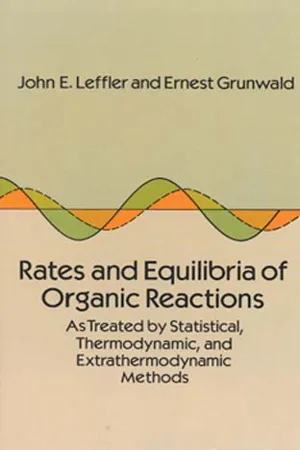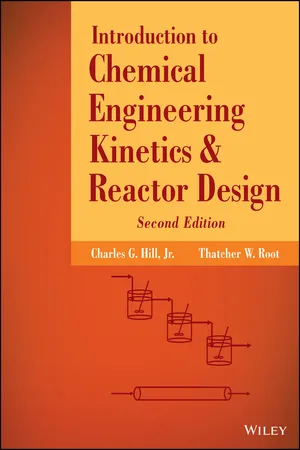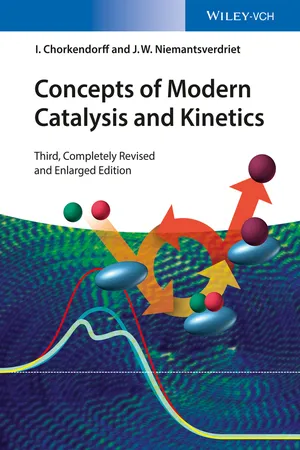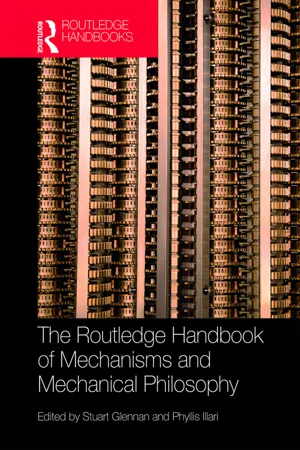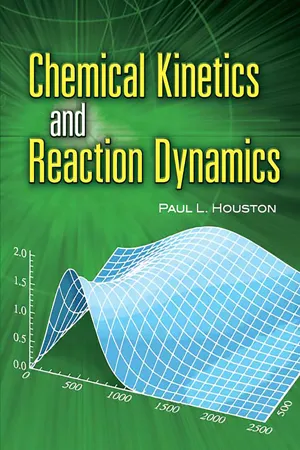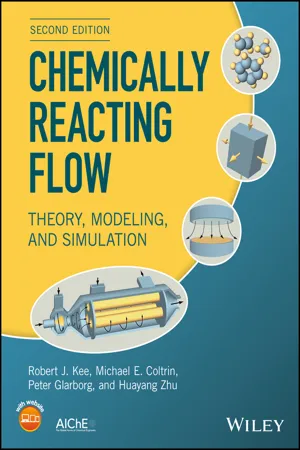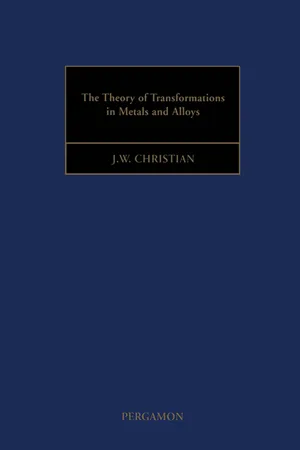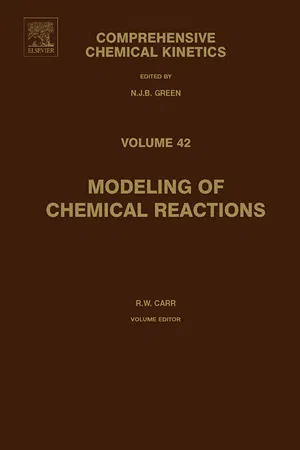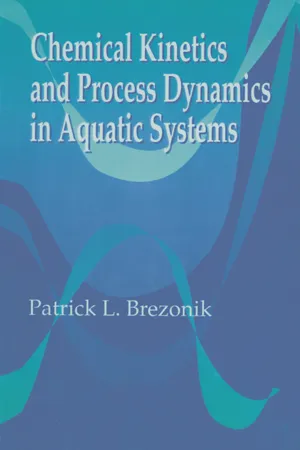Chemistry
Collision Theory
Collision theory in chemistry explains that chemical reactions occur when reactant molecules collide with sufficient energy and proper orientation. The theory emphasizes the importance of collision frequency, energy, and orientation in determining the rate of a chemical reaction. It provides a framework for understanding the factors that influence reaction rates and the conditions necessary for successful collisions to occur.
Written by Perlego with AI-assistance
Related key terms
Related key terms
1 of 4
Related key terms
1 of 3
10 Key excerpts on "Collision Theory"
- eBook - ePub
- John T. Moore(Author)
- 2019(Publication Date)
- For Dummies(Publisher)
In this reaction, all reactants and products are invisible, but you do feel another product of the reaction: heat. The heat being evolved is the clue that tells you a reaction is taking place.Collision Theory: How Reactions Occur
For a chemical reaction to take place, the reactants must collide. This collision transfers kinetic energy (energy of motion) from one substance to the other. The collision between the molecules provides the energy needed to break the necessary bonds so that new bonds can form. In this section, I discuss two criteria for breaking bonds: The reactants have to collide in the right place, and they have to hit with enough energy to break the bonds.Hitting the right spot
The molecules must collide in the right orientation, or hit at the right spot, in order for the reaction to occur. The place on the molecule where the collision must take place is called the reactive site . For example, suppose you have an equation showing molecule A-B reacting with C to form C-A and B, like this:The way this equation is written, the reaction requires that reactant C collide with A-B on the A end of the molecule. (You know this because the product side shows C hooked up with A — C-A.) If it hits the B end, nothing will happen. The A end of this hypothetical molecule is the reactive site. If C collides at the A end of the molecule, then there’s a chance that enough energy can be transferred to break the A-B bond. After the A-B bond is broken, the C-A bond can form. You can show the equation for this reaction process in this way (I show the breaking of the A-B bond and the forming of the C-A bond as “squiggly” bonds):So for this reaction to occur, there must be a collision between C and A-B at the reactive site.Note that this example is a simple one. I’ve assumed that only one collision is needed, making this a one-step reaction. Many reactions are one-step, but many others require several steps in going from reactants to final products. In the process, several compounds may be formed that react with each other to give the final products. These compounds are called intermediates. You show them in the reaction mechanism, - eBook - ePub
Rates and Equilibria of Organic Reactions
As Treated by Statistical, Thermodynamic and Extrathermodynamic Methods
- John E. Leffler, Ernest Grunwald(Authors)
- 2013(Publication Date)
- Dover Publications(Publisher)
4Concerning Rates of Reaction
No single thing abides, but all things flow. Fragment to fragment clings and thus they grow Until we know and name them. Then by degrees they change and are no more The things we know.LucretiusThere are two principal theories in use for dealing with the problem of reaction rates. The Collision Theory is based largely on the kinetic theory of gases and uses a mechanical model; the transition state theory is based largely on thermodynamics and uses a three-dimensional surface as a model, the vertical coordinate being the energy. Either theory is simple enough so that a useful qualitative insight into the nature of rate processes can be gained by visualizing the model for a given reaction. Although the transition state theory is the more generally useful of the two, particularly for organic reactions, the Collision Theory is nevertheless convenient for certain special purposes and is of historical importance because of the influence it has. had on modes of thinking about reaction mechanisms.THE Collision Theory
The basic assumption of the Collision Theory is that reaction is the result of a collision but that the collision is ineffective unless the kinetic energy of the colliding molecules along their line of centers equals or exceeds a critical value called the activation energy. The necessity for proper orientations and other requirements independent of the energy of the colliding molecules gives rise to an additional parameter in the theory, the probability factor, P. The rate constant or rate at unit concentrations of the reagents is given by equation 1.(1)The factor Z is the frequency at which collisions occur between the reagent molecules when they are present at unit concentration. According to the kinetic theory of gases, the frequency of collisions between molecules of two species A and B - Charles G. Hill, Thatcher W. Root(Authors)
- 2014(Publication Date)
- Wiley(Publisher)
4.2.7 Cautionary Note on Reaction Mechanisms
It is appropriate to conclude our discussion of reaction mechanisms on a note of caution. A mechanism is merely a logical hypothesis as to the sequence of molecular events that occur during the course of a chemical reaction. Reaction mechanisms should not be regarded as experimental facts. They are plausible explanations of experimental data that are consistent with the data, but that may be subject to revision as new data are obtained. Even if a proposed mechanism gives agreement with all available experimental facts, this is not evidence that the mechanism is unique or that other mechanisms could not give such agreement.4.3 Molecular Theories of Chemical Kinetics
A “complete” theory of reaction kinetics would provide a basis for calculating the rate of an elementary reaction from a knowledge of the properties of the reacting molecules and their concentrations. In terms of the present state of our theoretical knowledge, a complete theory can be regarded as a goal that is far, far down the road. While existing theories are extremely unsatisfactory, chemical engineers must be cognizant of their primary features.4.3.1 Simple Collision Theory
Before a chemical reaction can occur, energy must be available and localized such that it is possible to break and make certain chemical bonds in the reactant molecules. Moreover, the participants in the reaction must be in a spatial configuration such that it is possible for the necessary atomic and electronic rearrangements to occur. The most common means by which such redistributions of energy and changes in geometric configurations can occur are molecular collision processes. In this sense all theories of reaction are collision theories. However, we use this term in a more limited sense. We restrict its use to the theory that links chemical kinetics to the kinetic theory of gases by the use of the theoretical expression for bimolecular collision frequencies.- eBook - ePub
- I. Chorkendorff, J. W. Niemantsverdriet(Authors)
- 2017(Publication Date)
- Wiley-VCH(Publisher)
The two reaction rate theories discussed in this chapter are both based on the concept that reacting molecules acquire energy by collisions, thereby reaching an activated state (the top of the activation barrier) from which the product forms. Collision Theory treats reacting molecules as billiard balls or hard spheres, for which only the kinetic energy upon collision determines whether the activation barrier can be crossed. Transition state theory includes the vibrations and rotations of the reacting molecules, which are heavily involved in the exchange of energy when molecules collide. These are also the degrees of freedom that are excited when a reacting complex passes over the activation barrier.To understand how Collision Theory has been derived, we need to know the velocity distribution of molecules at a given temperature, as it is given by the Maxwell–Boltzmann distribution. To use transition state theory, we need the partition functions that follow from the Boltzmann distribution. Hence, we must devote a section of this chapter to statistical thermodynamics.Collisions play a tremendously important role in stimulating reacting systems to cross the activation barrier. The theory of Lindemann emphasizes this and provides us with a method to describe the influence of the surrounding medium upon a chemical reaction. It gives important insight in the conditions under which the reaction rate theories discussed here are valid.Finally, we will apply transition state theory and Collision Theory on some of the elementary surface reactions that are important in catalysis.3.2 The Boltzmann Distribution and the Partition Function
Here, we briefly summarize statistical thermodynamics, as far as we need it in this chapter. For a thorough coverage of the subject we refer the reader to Atkins’ Physical Chemistry [2].Suppose we have a large ensemble of particles (electrons, atoms, molecules) with energy levels εi, with i = 0, 1, 2, … , N, where N may also be infinitely large. A large number is mandatory since we want to derive meaningful averages. According to the Boltzmann distribution, the chance Pithat we find the system at a temperature T in a state with energy εi - Stuart Glennan, Phyllis Illari, Stuart Glennan, Phyllis Illari(Authors)
- 2017(Publication Date)
- Routledge(Publisher)
6 The Transition State Theory, on the other hand, was taken up by organic chemists who are principally interested in reactions that take place in solution. The Transition State Theory, described in (Hammett, 1940, pp. 115–18) and (Ingold, 1953, pp. 43–52), is an extension or articulation of the thermodynamics of chemical equilibria onto the problem of reaction rates. To appreciate its significance, it is first important to see how organic chemists were able to use chemical thermodynamics, in conjunction with their newly refined understanding of chemical bonding, to understand or rationalize the effects of changes in chemical structure or medium on a chemical equilibrium.According to chemical thermodynamics, the eventual balance between reactants and products in a chemical reaction depends on their difference in a thermodynamic quantity known as the “free” energy. Subject to some important caveats and exceptions, it is often possible in the sorts of circumstances relevant to the organic chemist to make predictions (typically qualitative or relative) about how this free energy difference will change as a result of changes in either the chemical structures of the species in equilibrium or the medium in which the equilibrium takes place. So, for instance, by appealing to Ingold’s inductive effect, one might predict that replacing one atom in a reactant structure with a more electronegative atom would result in products that are, relatively speaking, of even lower energy. This would result in changes to the overall free energy change in the reaction, thereby changing the eventual balance between reactants and products in an anticipatable way. In other words, chemical thermodynamics, in concert with the updated accounts of chemical bonding and interaction, allows for a structural analysis of the eventual balance between reactants and products. This is a further step on the path of fulfilling Butlerov’s ambition for structural chemistry in that features of a chemical reaction (the eventual balance between reactants and products) can be explained in terms of the structures of the reacting species.- eBook - ePub
- Paul L. Houston(Author)
- 2012(Publication Date)
- Dover Publications(Publisher)
3Theories of Chemical Reactions
Chapter Outline 3.1 Introduction 3.2 Potential Energy Surfaces 3.3 Collision Theory 3.4 Activated Complex Theory (ACT) 3.5 Thermodynamic Interpretation of ACT 3.6 Summary3.1 INTRODUCTION
The goal of this chapter is to provide a theoretical basis for understanding and predicting reaction rates. We begin by considering an encounter between two gas-phase reactants, and we assume that on the microscopic level, the outcome and rate of the reaction are determined by the forces acting between atoms making up the reactants. We would like to know what those forces are, or equivalently, what the potential is, since the force is simply proportional to the slope of the potential, F x = —dV /dx . Because we will rarely be able to know the potential in complete detail, it will also be of interest to determine which of its features are most responsible for determining the reaction rate, or conversely, which features are determined most accurately by measuring the reaction rate.Two simple theories of reaction rates will be considered in detail: Collision Theory and activated complex theory. Both of these theories make approximations about the potential energy function controlling the reaction, and both theories relate the rate constant to simple features of the potential energy function. In its simplest form, Collision Theory concentrates primarily on the barrier to reaction, while activated complex theory includes not only the barrier but also some information about the “width” of the channel leading from reactants to products. Our goal here will be to explore these general properties of the potential energy function and to learn what approximations are made in these simple theories of reaction rates. We leave until Chapter 8, Molecular Reaction Dynamics, the question of how more detailed investigations can provide closer approximations to the potential energy function. A thermodynamic formulation of activated complex theory will provide us with an association between the entropy change between reactants and activated complexes and the orientational requirements for reaction. - eBook - ePub
Chemically Reacting Flow
Theory, Modeling, and Simulation
- Robert J. Kee, Michael E. Coltrin, Peter Glarborg, Huayang Zhu(Authors)
- 2017(Publication Date)
- Wiley(Publisher)
CHAPTER 13 REACTION RATE THEORIESChemical kinetics govern the rate at which chemical species are created or destroyed via reactions. Chapter 12 discussed chemical kinetics of reactions in the gas phase. Reactions were assumed to follow the law of mass action. Rates are determined by the concentrations of the chemical species involved in the reaction and an experimentally determined rate coefficient (or rate constant) k.This chapter describes the underlying theoretical basis for the rates of chemical reactions. In particular, it presents the factors that determine the magnitude of the rate constant for reactions.Elementary reactions are initiated by molecular collisions in the gas phase. Many aspects of these collisions determine the magnitude of the rate constant, including the energy distributions of the collision partners, bond strengths, and internal barriers to reaction. Section 13.1 discusses the distribution of energies in collisions and the molecular collision frequency; both factors lead to the simple collision-theory expression for the reaction rate constant k, which is derived in Section 13.2. Transition-state theory is derived in Section 13.3. The Lindemann theory of the pressure-dependence observed in unimolecular reactions was introduced in Chapter 12. Section 13.4 extends the treatment of unimolecular reactions to more detailed and physically based theories that characterize the pressure and temperature dependencies of these reaction. Analogous pressure effects are seen in a class of bimolecular reactions called chemical activation reactions, which are discussed in Section 13.5.13.1 Molecular Collisions
13.1.1 Energy Distribution Functions
The Boltzmann distribution of the populations of a collection of molecules at some temperature T was discussed in Section 10.3. This distribution, given by Eq. 10.24, was expressed in terms of the quantum mechanical energy levels and the partition function for a particular type of motion, for instance, translational, vibrational, or rotational motion. It is useful to express such population distributions in other forms, particularly to obtain an expression for the distribution of velocities. The velocity distribution function basically determines the (translational) energy available for overcoming a reaction barrier. It also determines the frequency of collisions, which directly contributes to the rate constant k - John Christian(Author)
- 2002(Publication Date)
- Pergamon(Publisher)
CHAPTER 3The Theory of Reaction Rates
12 CHEMICAL KINETICS AND ACTIVATION ENERGY
A typical problem in the theory of transformation is the motion of an interface separating two regions of different composition. Provided we interpret the term “chemical reaction” in a rather more liberal sense than is usual, we may regard the growth of the more stable region as the combination of a transport process (atomic diffusion) with a chemical reaction (formation of a new phase). Moreover, the transport process may itself be regarded as a series of chemical reactions, and this concept has proved very useful. Under appropriate circumstances, we may use theories which have been developed to describe the kinetics of chemical reactions and extend them to analogous phenomena such as diffusion.Most descriptions of chemical kinetics are based on a statistical theory developed by Eyring and his co-workers (Glasstone et al. , 1941). This theory depends on the assignation of thermodynamic properties to non-equilibrium states, and is now usually known as the “absolute reaction rate theory” or as the “transition state theory”. Despite its success in chemical problems, the claim implicit in the first name seems a little too ambitious, since calculation of reaction rates from first principles is seldom possible in practice. When applied to metallic assemblies, the method has yielded useful results, but we must emphasize at once that there are many solid state phenomena for which it is clearly not valid. Reaction rate theory should therefore be applied only after careful consideration of the probable physical mechanism of the process considered. When this mechanism appears to be consistent with the postulates of the theory, as discussed below, the chemical analogy may be useful, but in other cases it may be misleading.The basic assumption of Eyring’s theory is that the whole reaction consists of the repetition of a fundamental unit step, or series of such steps. Each unit step arises from the interaction of a small- eBook - ePub
- R.W. Carr(Author)
- 2007(Publication Date)
- Elsevier Science(Publisher)
Chapter 3 Elements of Chemical KineticsRobert W. CarrAbstractPublisher Summary
This chapter focuses on the definitions and underlying principles of chemical kinetics and provides an introduction to the theory of elementary reactions as well as discussing unimolecular reactions. The elementary concepts discussed are stoichiometry, the reaction rate of conversion of reactants into products, the rate expression, elementary reactions, state-to-state kinetics, the temperature dependence of the rate coefficient, kinetic data, mechanism of reaction, the steady-state approximation, and microscopic reversibility and detailed balance. The potential energy of interaction among atoms, molecules, ions, and free radicals plays a central role in determining the chemical reactivity of these species. The Born–Oppenheimer approximation, long-range interactions, short-range repulsive forces, bonding interactions, and potential energy surfaces are discussed. The chapter also discusses the bimolecular-reaction rate theory, simple Collision Theory (SCT), bimolecular collision dynamics, ion–ion reactions, bimolecular association of free radicals, classical trajectory calculations, transition state theory (TST), tests of TST, microcanonical TST, variational TST, the transmission coefficient, quantum tunneling, electronically non-adiabatic reactions, and thermolecular reactions.1 Introduction
This chapter is a primer on chemical kinetics. It should be useful to anyone who finds it desirable or necessary to get started on modeling a complex chemical reaction, and whose background does not include training in kinetics, or who wishes to brush up. Although the material in this chapter can be found in standard textbooks on kinetics, several of which are referenced below, it was thought that having a basic overview of the subject readily at hand would be a welcome convenience. Consulting other texts will be necessary to fill in many of the details. The chapter is divided into two parts. The first part is concerned with definitions and underlying principles of chemical kinetics; the second part provides an introduction to the theory of elementary reactions, with the exception of unimolecular reactions which are covered in Chapter 4. - Patrick L. Brezonik(Author)
- 2018(Publication Date)
- CRC Press(Publisher)
−6 are difficult to explain on the basis of steric effects. Classical Collision Theory, which treats reacting molecules as structureless, hard spheres, thus is not adequate to predict reaction rates from first principles because it does not take molecular complexity into account, except in terms of the empirical steric factor. Vibrational and rotational energy states for reacting molecules must be considered for a more accurate rate model, and this requires quantum or statistical mechanical approaches.3.4.5 Reconciliation of First-Order Reactions with Collision Theory: The Lindeman ModelThe fact that many reactions are first order would seem to pose major difficulties for classical Collision Theory. The activation energy should come from the kinetic energy provided by collision, but first-order kinetics implies that the rate does not depend on collision frequency. Lindeman28 explained this by postulating a mechanism with a time lag between activation and reaction:A + A⇌A +k− 1k 1A *(3-35a) A *→Pk 2(3-35b) Some fraction of collisions of A with other molecules of A (or any other molecule M) results in energy gain to an activated state A≠
Index pages curate the most relevant extracts from our library of academic textbooks. They’ve been created using an in-house natural language model (NLM), each adding context and meaning to key research topics.
Explore more topic indexes
Explore more topic indexes
1 of 6
Explore more topic indexes
1 of 4
